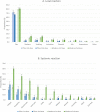COVID-19 mRNA vaccine in pregnancy: Results of the Swiss COVI-PREG registry, an observational prospective cohort study
- PMID: 35651954
- PMCID: PMC9148537
- DOI: 10.1016/j.lanepe.2022.100410
COVID-19 mRNA vaccine in pregnancy: Results of the Swiss COVI-PREG registry, an observational prospective cohort study
Abstract
Background: Pregnant individuals with coronavirus disease 2019 (COVID-19) are at increased risk of severe disease, prematurity, and stillbirth. In March 2021, vaccination for at risk pregnant women was recommended in Switzerland, expanding this to all pregnant women in May 2021. Our aim was to assess the safety of mRNA COVID-19 vaccines in pregnancy.
Methods: This multicentre prospective cohort study describes early adverse events and perinatal outcomes in pregnant women who received at least one dose of mRNA vaccine between March 1st and December 27th, 2021 in Switzerland, using the COVI-PREG registry. Early adverse events were collected at least one month following vaccine administration. Pregnancy and neonatal outcomes were extracted from medical records using the maternity discharge letters providing follow-up information up to 5 days after birth.
Findings: Of 1012 vaccinated women, 894 (88·3%) received both injections during pregnancy, with BNT162b2 (n = 271) or mRNA-1273 (n = 623) vaccines. Local events (mainly local pain) were reported in 81·3% and 80·5% after the first and second doses. Rates of systemic reactions (mainly fatigue and headache) were similar after the first dose and most frequent after the second dose of mRNA-1273. Of the 1012 women, four (0·4%; 95%CI [0·1-1·0]) severe early adverse events occurred: pulmonary embolism, preterm premature rupture of membranes, isolated fever with hospitalisation, and herpes zoster. Of 107 patients vaccinated before 14 weeks, one (0·9%; 95%CI [0·0-5·1]) early spontaneous abortions was reported (8 weeks). Of 228 vaccinated before 20 weeks one (0·4%; 95%CI [0·0-2·4]) late spontaneous abortion was reported (16 weeks). Of 513 women exposed before 37 weeks, 33 (6·4%; 95%CI [4·5-8·9]) delivered preterm. Among 530 patients exposed in pregnancy, no stillbirth was reported and 25 (4·7%; 95%CI [3·0-6·8]) neonates were admitted to intensive care unit.
Interpretation: Frequent local and systemic effects were described after exposure to mRNA COVID-19 vaccines during pregnancy but severe events were rare. Women vaccinated during pregnancy did not experience higher adverse pregnancy or neonatal outcomes when compared to historical data on background risks in the obstetric population.
Funding: This research was funded by a grant from the Swiss Federal Office of Public Health and the CHUV Foundation.
Keywords: COVID-19; Pregnancy; Pregnant women; SARS-CoV-2; Safety; Vaccine; mRNA.
© 2022 The Author(s).
Conflict of interest statement
All authors have completed the ICMJE uniform disclosure form at www.icmje.org/coi_disclosure.pdf. Alice Panchaud received grants from the Swiss Federal Office of Public Health and the CHUV Foundation; she also received grants from Vifor, the European Medicine Agency (EMA/2017/09/PE and EMA/2017/09/PE/11), the Fonds Paritaire RBP IV and a H2020 grant (ConcePTION WP 3-4), outside the submitted work. Begoña Martinez de Tejada reported receiving financial support from the General Health Division in Geneva, Switzerland, and being a medical advisor for Effik consulting fees and lectures) and Pierre Fabre (consulting fees), outside the submitted work; she also reported having a research agreement for clinical devices with Pregnolia and having been paid as a legal expert in a malpractice case, outside the submitted work. All other authors declare no conflicts of interest
Figures


Similar articles
-
Short-term outcome of pregnant women vaccinated with BNT162b2 mRNA COVID-19 vaccine.Ultrasound Obstet Gynecol. 2021 Sep;58(3):450-456. doi: 10.1002/uog.23729. Epub 2021 Aug 9. Ultrasound Obstet Gynecol. 2021. PMID: 34198360 Free PMC article.
-
COVID-19 vaccination in pregnancy: early experience from a single institution.Am J Obstet Gynecol MFM. 2021 Nov;3(6):100464. doi: 10.1016/j.ajogmf.2021.100464. Epub 2021 Aug 16. Am J Obstet Gynecol MFM. 2021. PMID: 34411758 Free PMC article.
-
COVID-19 vaccination during pregnancy: coverage and safety.Am J Obstet Gynecol. 2022 Feb;226(2):236.e1-236.e14. doi: 10.1016/j.ajog.2021.08.007. Epub 2021 Aug 10. Am J Obstet Gynecol. 2022. PMID: 34389291 Free PMC article.
-
Safety monitoring of bivalent mRNA COVID-19 vaccine among pregnant persons in the vaccine adverse event reporting System - United States, September 1, 2022 - March 31, 2023.Vaccine. 2024 Apr 2;42(9):2380-2384. doi: 10.1016/j.vaccine.2024.02.084. Epub 2024 Mar 11. Vaccine. 2024. PMID: 38462432 Review.
-
Vaccines for preventing influenza in healthy adults.Cochrane Database Syst Rev. 2018 Feb 1;2(2):CD001269. doi: 10.1002/14651858.CD001269.pub6. Cochrane Database Syst Rev. 2018. PMID: 29388196 Free PMC article. Review.
Cited by
-
Use of Sotrovimab in Pregnancy: Experiences from the COVID-19 International Drug Pregnancy Registry.Drug Saf. 2024 Sep;47(9):843-851. doi: 10.1007/s40264-024-01439-z. Epub 2024 May 9. Drug Saf. 2024. PMID: 38727875 Free PMC article.
-
COVID-Vaccines in Pregnancy: Maternal and Neonatal Response over the First 9 Months after Delivery.Biomolecules. 2024 Apr 3;14(4):435. doi: 10.3390/biom14040435. Biomolecules. 2024. PMID: 38672452 Free PMC article.
-
Effectiveness and safety of COVID-19 vaccines on maternal and perinatal outcomes: a systematic review and meta-analysis.BMJ Glob Health. 2024 Apr 4;9(4):e014247. doi: 10.1136/bmjgh-2023-014247. BMJ Glob Health. 2024. PMID: 38580375 Free PMC article.
-
Causes and Effects of COVID-19 Vaccine Hesitancy Among Pregnant Women and its Association with Adverse Maternal, Placental, and Perinatal Outcomes.Yale J Biol Med. 2024 Mar 29;97(1):73-84. doi: 10.59249/LPOQ5146. eCollection 2024 Mar. Yale J Biol Med. 2024. PMID: 38559465 Free PMC article. Review.
-
Patisiran exposure in early pregnancy: a case report.Ther Adv Neurol Disord. 2024 Mar 26;17:17562864241239755. doi: 10.1177/17562864241239755. eCollection 2024. Ther Adv Neurol Disord. 2024. PMID: 38532802 Free PMC article.
References
LinkOut - more resources
Full Text Sources
Miscellaneous

